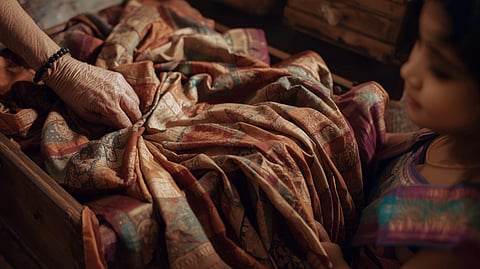

The most sustainable clothes are the ones already in your closet. This story promotes the beautiful tradition of passing down high-quality, pre-loved ethnic wear — especially hand-embroidered silks and timeless sarees — as the ultimate Diwali gift. We provide tips on professionally restoring and packaging an heirloom piece, making it a cherished, zero-carbon-footprint gift that carries sentimental value, replacing the need to buy fast-fashion alternatives.
The Sentimental Value of the Sari
A mother's or grandmother's silk saree isn't just fabric; it's a repository of memories and a testament to the quality of slow fashion. The zero-carbon footprint of a pre-loved garment immediately makes it the most sustainable item in your closet. By choosing to gift an heirloom, you are championing longevity and tradition over wasteful consumption.
Restoration Guide: Giving a New Life
To make an heirloom piece feel brand new, a little care goes a long way. This ensures the gift is both cherished and immediately wearable:
1. Professional Cleaning: Have the garment professionally dry-cleaned, specifically detailing any delicate work (zari, embroidery).
2. Minor Alterations: A local tailor (darzi) can update the fit of a blouse, replace the fall of a saree, or modernize the cut of a kurta. Small changes can transform the silhouette.
3. Accessorize the Old: Pair the heirloom with a contemporary accessory—a simple silver belt or a modern neckline—to make it relevant for the recipient.
Presentation is Everything
The key to a successful heirloom gift is the narrative. Do not just hand it over.
1. The Story: Write a handwritten note detailing the history of the garment: who wore it, where, and what the occasion was. This transfers the sentimental value.
2. Packaging: Wrap the heirloom in a fresh, reusable pure muslin cloth or a quality saree bag — avoiding plastic and cardboard. This not only preserves the fabric but elevates the presentation.
This Diwali, let your gift tell a story of family, sustainability, and enduring beauty. The greatest acts of conscious consumerism often involve buying nothing new at all.
